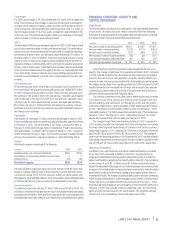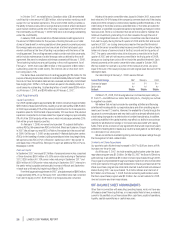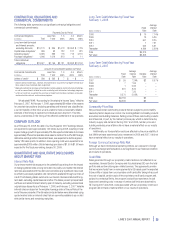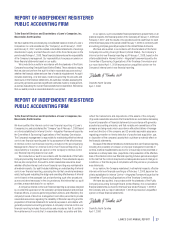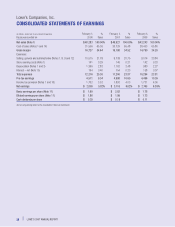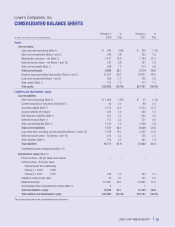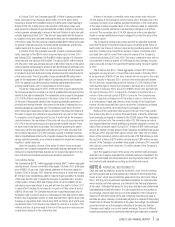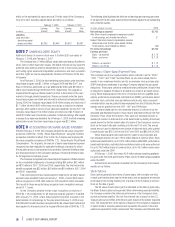Lowe's 2007 Annual Report Download - page 34
Download and view the complete annual report
Please find page 34 of the 2007 Lowe's annual report below. You can navigate through the pages in the report by either clicking on the pages listed below, or by using the keyword search tool below to find specific information within the annual report.32 |LOWE’S 2007 ANNUAL REPORT
NOTES to Consolidated Financial Statements
Years ended February 1, 2008, February 2, 2007 and February 3, 2006
NOTE 1 SUMMARY OF SIGNIFICANT
ACCOUNTING POLICIES
Lowe’s Companies, Inc. and subsidiaries (the Company) is the world’s second-
largest home improvement retailer and operated 1,534 stores in the United
States and Canada at February 1, 2008. Below are those accounting policies
considered by the Company to be significant.
Fiscal Year – The Company’s fiscal year ends on the Friday nearest the
end of January.The fiscal years ended February 1, 2008 and February 2, 2007
contained 52 weeks. The fiscal year ended February 3, 2006 contained 53
weeks. All references herein for the years 2007, 2006 and 2005 represent
the fiscal years ended February 1, 2008, February 2, 2007 and February 3,
2006, respectively.
Principles of Consolidation – The consolidated financial statements
include the accounts of the Company and its wholly-owned or controlled
operating subsidiaries. All material intercompany accounts and transactions
have been eliminated.
Use of Estimates – The preparation of the Company’s financial statements
in accordance with accounting principles generally accepted in the United
States of America requires management to make estimates that affect the
reported amounts of assets, liabilities, sales and expenses, and related
disclosures of contingent assets and liabilities. The Company bases these
estimates on historical results and various other assumptions believed to be
reasonable, all of which form the basis for making estimates concerning the
carrying values of assets and liabilities that are not readily available from
other sources. Actual results may differ from these estimates.
Cash and Cash Equivalents – Cash and cash equivalents include cash on
hand, demand deposits and short-term investments with original maturities of
three months or less when purchased. The majority of payments due from
financial institutions for the settlement of credit card and debit card transac-
tions process within two business days and are, therefore, classified as cash
and cash equivalents.
Investments – The Company has a cash management program which
provides for the investment of cash balances not expected to be used in current
operations in financial instruments that have maturities of up to 10 years.
Variable-rate demand notes, which have stated maturity dates in excess of
10 years, meet this maturity requirement of the cash management program
because the maturity date of these investments is determined based on
the interest rate reset date or par value put date for the purpose of applying
this criteria.
Investments, exclusive of cash equivalents, with a stated maturity date
of one year or less from the balance sheet date or that are expected to be
used in current operations, are classified as short-term investments. All other
investments are classified as long-term. As of February 1, 2008, investments
consisted primarily of money market funds, certificates of deposit, municipal
obligations and mutual funds. Restricted balances pledged as collateral for
letters of credit for the Company’s extended warranty program and for a portion
of the Company’s casualty insurance and installed sales program liabilities are
also classified as investments.
The Company has classified all investment securities as available-for-sale,
and they are carried at fair market value. Unrealized gains and losses on
such securities are included in accumulated other comprehensive income in
shareholders’ equity.
Merchandise Inventory – Inventory is stated at the lower of cost or market
using the first-in, first-out method of inventory accounting.The cost of inventory
also includes certain costs associated with the preparation of inventory for resale
and distribution center costs, net of vendor funds.
The Company records an inventory reserve for the loss associated with
selling inventories below cost.This reserve is based on management’s current
knowledge with respect to inventory levels, sales trends and historical expe-
rience. Management does not believe the Company’s merchandise inventories
are subject to significant risk of obsolescence in the near term, and management
has the ability to adjust purchasing practices based on anticipated sales trends
and general economic conditions. However, changes in consumer purchasing
patterns could result in the need for additional reserves. The Company also
records an inventory reserve for the estimated shrinkage between physical
inventories. This reserve is based primarily on actual shrink results from pre-
vious physical inventories. Changes in the estimated shrink reserve may be
necessary based on the results of physical inventories. Management believes
it has sufficient current and historical knowledge to record reasonable estimates
for both of these inventory reserves.
Derivative Financial Instruments – The Company occasionally utilizes
derivative financial instruments to manage certain business risks. However,
the amounts were not material to the Company’s consolidated financial
statements in any of the years presented.The Company does not use derivative
financial instruments for trading purposes.
Credit Programs – The majority of the Company’s accounts receivable arises
from sales of goods and services to Commercial Business Customers. In
May 2004, the Company entered into an agreement with General Electric
Company and its subsidiaries (GE) to sell its then-existing portfolio of commer-
cial business accounts receivable to GE. During the term of the agreement,
which ends on December 31, 2016, unless terminated sooner by the parties,
GE also purchases at face value new commercial business accounts receivable
originated by the Company and services these accounts. The Company
accounts for these transfers as sales of accounts receivable.When the Company
sells its commercial business accounts receivable, it retains certain interests
in those receivables, including the funding of a loss reserve and its obligation
related to GE’s ongoing servicing of the receivables sold. Any gain or loss on
the sale is determined based on the previous carrying amounts of the trans-
ferred assets allocated at fair value between the receivables sold and the interests
retained. Fair value is based on the present value of expected future cash
flows, taking into account the key assumptions of anticipated credit losses,
payment rates, late fee rates, GE’s servicing costs and the discount rate
commensurate with the uncertainty involved. Due to the short-term nature
of the receivables sold, changes to the key assumptions would not materially
impact the recorded gain or loss on the sales of receivables or the fair value
of the retained interests in the receivables.
Total commercial business accounts receivable sold to GE were $1.8 billion
in both 2007 and 2006, and $1.7 billion in 2005.During 2007,2006 and 2005,
the Company recognized losses of $34 million, $35 million and $41 million,
respectively, on these sales as selling, general and administrative (SG&A)
expense, which primarily relates to the fair value of the obligations incurred
related to servicing costs that are remitted to GE monthly.At February 1,
2008 and February 2, 2007, the fair value of the retained interests was
insignificant and was determined based on the present value of expected
future cash flows.
Sales generated through the Company’s proprietary credit cards
are not reflected in receivables. Under an agreement with GE, credit is
extended directly to customers by GE.All credit program-related services are
performed and controlled directly by GE. The Company has the option, but
no obligation, to purchase the receivables at the end of the agreement in
December 2016.Tender costs, including amounts associated with accepting the
Company’s proprietary credit cards, are recorded in SG&A in the consolidated
financial statements.



